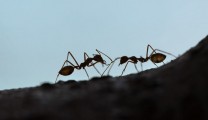Ants are capable of creating incredible structures out of nothing more than dirt; structures that in comparison would be as high as a skyscraper. Bridges which allow them to go on expeditions and water rafts to escape from flooding.
Ant colonies are illustrated as super organisms. A collection of organisms, which behave as one single organism. The ants work through collective intelligence, even though they are incapable of conscious organization.
It’s astonishing and incredibly inspiring to think that these teeny tiny insects with equally teeny tiny brains, are able to create such marvellous things.
Scientists have been studying the behaviour of ants for decades. They are some way towards understanding the rules that apply in the ant world in terms of survival, but they are still searching for clues as to how they coordinate behaviour, without the presence of a leader.
What is understood is that ants follow the formula of a complex decentralized system. Everything they do is based on the interaction of many individual ants, rather than having one leader who delegates tasks down the hierarchy. And they follow a few simple rules to make that system a success.

One of those rules is the need to interact at a local level. When ants are constructing, they interact with other ants on a local level. The ants who are collecting the dirt collaborate; those that are creating a pile of dirt work together, and those who are forming the structure, also stick together. The structures they are working on emerge without any central coordination. Their organizational skills are phenomenal.
Although scientists are far from fully understanding how ants self-organize the way they do. And it’s still not conclusive as to why ants are so focused without leadership pressure. Organizations and manufacturers have been studying their scientific theories to see how the coordination behaviour of ants can be applied to workers and to manufacturing processes.
Self-organization in teams isn’t a new concept. Agile communities have been teaching teams how to self-organize for the last couple of decades. And now with more teams decentralized and working remotely, and more online tools available to help workers self-manage, the question of how to build a successful self-organizing team is mainstream.
When creating a successful human self-organized team, some level of leadership still needs to be in place. And unlike ant colonies, self-organizing teams do need good constraints in place. In fact research shows that creative workers like constraints. Good constraints can be effectively mapped out by using a delegation board.

Jurgen Appelo in his Seven Rules for Creativity Managers argues the case that self-organizing teams work at their optimum when there is a Creativity Manager to support them. One who is able to set good constraints, then stand back and allow the team to self-organize and innovate. The team know that there is someone who can support their needs, but who allows them the freedom to get on with the job.
Happy Melly One is a remote, self-organizing team. We decide how we play out our roles and how we interact and collaborate with other team members to get tasks and projects completed. We have very little pressure in terms of deadline delivery, but we always deliver.
LIke an ant colony, our successful self-organizing team is one that has the high ability to collaborate through good and bad times. And has the right attitude to steer the creation of our organization’s next skyscraper.
Human self-organization is still nowhere near as complex and ingenious as that of ant colonies, but we are capable of processing coordination and performance, without the intrusion of an external party. And companies are now seeing that a bottom-up self-organization model is far more effective in the engagement and motivation of workers, than a top down hierarchal system.












Replies to This Discussion